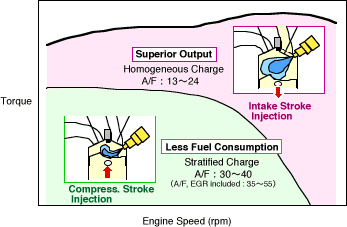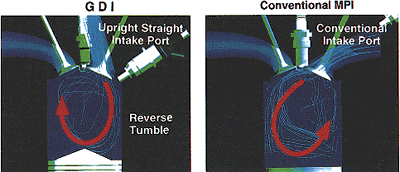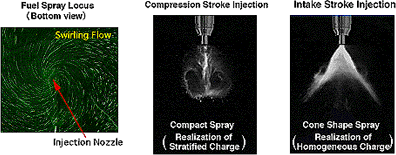
II.Major Objectives of the GDI engine
1.The difference between new GDI and current MPI
2.Outline
3.Technical features
III. Major characteristics of the GDI engine
1.Lower fuel consumption and higher output
2.Realization of lower fuel consumption
3.Realization of Superior Output
![]()
Animation
(2) The GDI engines foundation technologies
Animation
Under most normal driving conditions, up to speeds of 120km/h, the Mitsubishi GDI engine operates in ultra-lean combustion mode for less fuel consumption. In this mode, fuel injection occurs at the latter stage of the compression stroke and ignition occurs at an ultra-lean air-fuel ratio of 30 to 40 (35 to 55, included EGR).
When the GDI engine is operating with higher loads or at higher speeds, fuel injection takes place during the intake stroke. This optimizes combustion by ensuring a homogeneous, cooler air-fuel mixture that minimized the possibility of engine knocking.

![]() There are four technical features that make up the foundation technology. The Upright Straight Intake Port supplies optimal airflow into the cylinder. The Curved-top Piston controls combustion by helping shape the air-fuel mixture. The High Pressure Fuel Pump supplies the high pressure needed for direct in-cylinder injection. And the High Pressure Swirl Injector controls the vaporization and dispersion of the fuel spray.
There are four technical features that make up the foundation technology. The Upright Straight Intake Port supplies optimal airflow into the cylinder. The Curved-top Piston controls combustion by helping shape the air-fuel mixture. The High Pressure Fuel Pump supplies the high pressure needed for direct in-cylinder injection. And the High Pressure Swirl Injector controls the vaporization and dispersion of the fuel spray.
![]() These fundamental technologies, combined with other unique fuel control technologies, enabled Mitsubishi to achieve both of the development objectives, which were fuel consumption lower than those of diesel engines and output higher than those of conventional MPI engines. The methods are shown below.
These fundamental technologies, combined with other unique fuel control technologies, enabled Mitsubishi to achieve both of the development objectives, which were fuel consumption lower than those of diesel engines and output higher than those of conventional MPI engines. The methods are shown below.
The GDI engine has upright straight intake ports rather than horizontal intake ports used in conventional engines. The upright straight intake ports efficiently direct the airflow down at the curved-top piston, which redirects the airflow into a strong reverse tumble for optimal fuel injection.

Newly developed high-pressure swirl injectors provide the ideal spray pattern to match each engine operational modes. And at the same time by applying highly swirling motion to the entire fuel spray, they enable sufficient fuel atomization that is mandatory for the GDI even with a relatively low fuel pressure of 50kg/cm2.

![]()
 The curved-top piston controls the shape of the air-fuel mixture as well as the airflow inside the combustion chamber, and has an important role in maintaining a compact air fuel mixture. The mixture, which is injected late in the compression stroke, is carried toward the spark plug before it can disperse.
The curved-top piston controls the shape of the air-fuel mixture as well as the airflow inside the combustion chamber, and has an important role in maintaining a compact air fuel mixture. The mixture, which is injected late in the compression stroke, is carried toward the spark plug before it can disperse.
![]() Mitsubishis advanced in-cylinder observation techniques including laser-methods are utilized to determine the optimum piston shape.
Mitsubishis advanced in-cylinder observation techniques including laser-methods are utilized to determine the optimum piston shape.